
South Dakota used to be the third largest gold producer in the United States in the 1960s by gold ever produced. Read in the article about the history of gold mining in South Dakota, about its major active gold mines and other facts and figures about gold mining in SD.
Contents
- Is there Gold in South Dakota?
- Where is Gold in South Dakota?
- Why had there been so Much Gold in South Dakota?
- What is the History of Gold Mining in South Dakota?
- How Much Gold has been Mined in South Dakota?
- What is the Current State of Gold Mining in South Dakota?
- How Many Gold Reserves are in South Dakota?
- What Companies Mine Gold in South Dakota?
- Where are New Gold Mines Explored or Developed in South Dakota?
- Is it Legal to Mine Gold in South Dakota?
- Where Can I Pan for Gold in South Dakota?
- Is There Gold in Other US States?
Is there Gold in South Dakota?
Yes. However, gold production nowadays is limited to only one major gold operation with several open pit mines.
- South Dakota produced at this mine 2.83 tonnes of gold in 2021. This is around 1.5% of the US gold output of that year, which was 187 tonnes
- The US Geological Survey lists more than 500 areas with gold deposits in South Dakota, most of them closed (for comparison: California has more than 20.000 gold sites)
- There are two gold exploration projects in the state that might lead to mining operations

Key Takeaways:
| Fact | Explanation |
|---|---|
| Remember | One gold mine left, until the 1960s, 3rd biggest gold producer in the US, by gold ever produced |
| Gold Deposits | Yes |
| Discovery Year | 1874 (first substantial find) |
| Discoverer | The gentlemen Ross and McKay |
| Mining Industry | Still active |
| Major Gold Locations | In the black hills, historic mining sites |
| Major Active Gold Mines | one mining operation left: the Wharf Gold Mine |
| Mining Companies | Coeur Mining Inc. |
| Panning Locations | Rivers of the Black Hills: Rapid Creek, Castle Creek, and Spearfish Creek |
Check out the documentary from the 1940s about gold mining in South Dakota:
The following map of South Dakota shows the location of the first gold discovery and the location of the only gold mine left in the state.

Where is Gold in South Dakota?
Gold in South Dakota is primarily found in the Black Hills region, particularly in the area around Lead and Deadwood. This region is famous for its rich gold mining history, which dates back to the Black Hills Gold Rush in the late19th century. The Homestake Mine, located in Lead, was once the largest and deepest gold mine in North America before it closed in 2001.
Apart from the historic mines, there are numerous streams and rivers in the Black Hills where recreational gold panning is popular. Rapid Creek, Castle Creek, and Spearfish Creek are known locations for gold prospectors. It’s important for prospectors to be aware of the land ownership and mining laws in the area, as some lands are private or controlled by the government.
Today, while large-scale commercial gold mining has decreased, recreational panning and prospecting continue to attract enthusiasts to the region.
The next map shows gold mining locations in South Dakota in the 1960s:
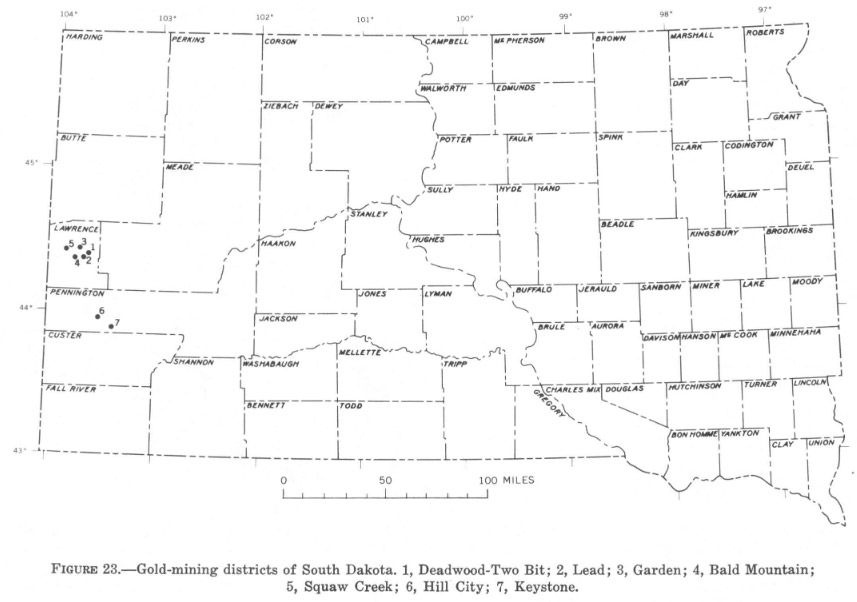
Sources: USGS
Why had there been so Much Gold in South Dakota?
The presence of significant gold deposits in South Dakota, particularly in the Black Hills region, is a result of a combination of geological processes and historical factors. Here are the key reasons:
Geological History: The Black Hills of South Dakota are an isolated mountain range that formed from ancient volcanic activity and the uplift of the Earth’s crust. This geological activity led to the formation of gold-bearing rocks and minerals. Over millions of years, erosion and other geological processes concentrated these gold deposits in certain areas, making them accessible for mining.
The Homestake Mine: One of the most famous gold mines in the United States, the Homestake Mine, is located in Lead, South Dakota. Discovered in 1876 during the Black Hills Gold Rush, this mine was one of the richest gold mines in America. It was unique because of its extensive deposits and the depth at which gold was found. The mine operated more than 125 years and produced an enormous amount of gold.
Placer and Hard Rock Mining: Initially, gold in the Black Hills was found in placer deposits – gold that had been eroded from the bedrock and deposited in streams and rivers. Later, more sophisticated mining techniques allowed miners to extract gold from hard rock, leading to the discovery of deeper and more extensive deposits. And also enabled more efficient extraction of gold from the ore, increasing the total yield from the mines in South Dakota.
Source: National Park Service, USGS
Check out the video about gold mining in South Dakota:
What is the History of Gold Mining in South Dakota?
Who discovered gold in South Dakota?
Gold was first discovered in South Dakota in 1874 by the two miners Ross and McKay at French Creek in the Black Hills. They were part of a military expedition led by Lieutenant Colonel George Armstrong Custer. This discovery sparked significant interest, leading to the Black Hills Gold Rush.
The first gold rush
The Black Hills Gold Rush began in 1874 and reached its peak in 1876-77, drawing thousands of prospectors to the area. Already in the first year of the gold discovery, 4.000 people entered the Black Hills. These gold seekers, known as miners, established boomtowns like Deadwood and Lead, which quickly grew as people flocked to the region in search of wealth.
Industrial mining
The most famous and productive mine in South Dakota’s history is the Homestake Mine, located in Lead. It was established in 1876 and became the largest and deepest gold mine in North America. In its first year, 5,000 ounces of gold were produced.
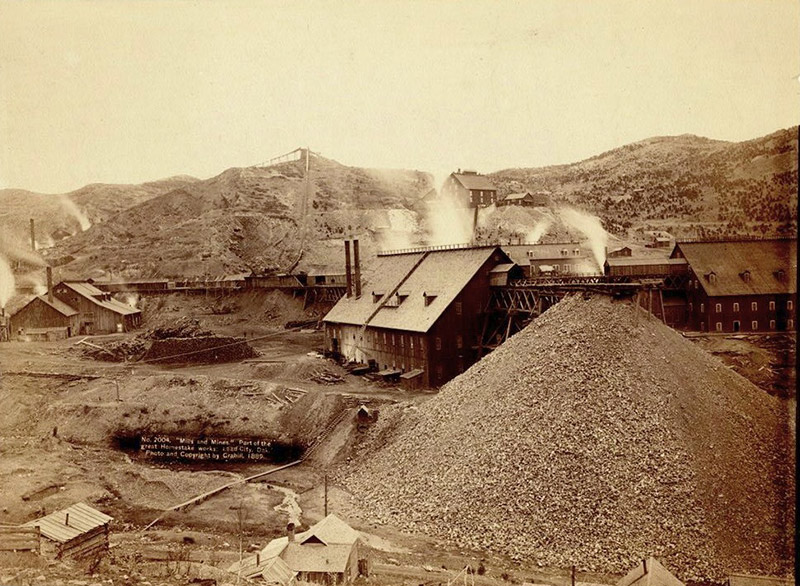
Over the years, the technology used in both mining and milling at Homestake underwent significant evolution.
By around 1900, the introduction of pneumatic drills in the mine boosted productivity. Additionally, cyanide processing was incorporated into the milling process to extract gold from sand tailings. To manage the increasing rock pressure due to the mine’s deepening, sand backfilling was initiated for shrinkage and square set stopes. Two significant shafts were completed: the Ross Shaft in 1934 and the Yates Shaft in 1941, each approximately 5,000 feet deep. At the time of their completion, their hoists were among the largest in the world.
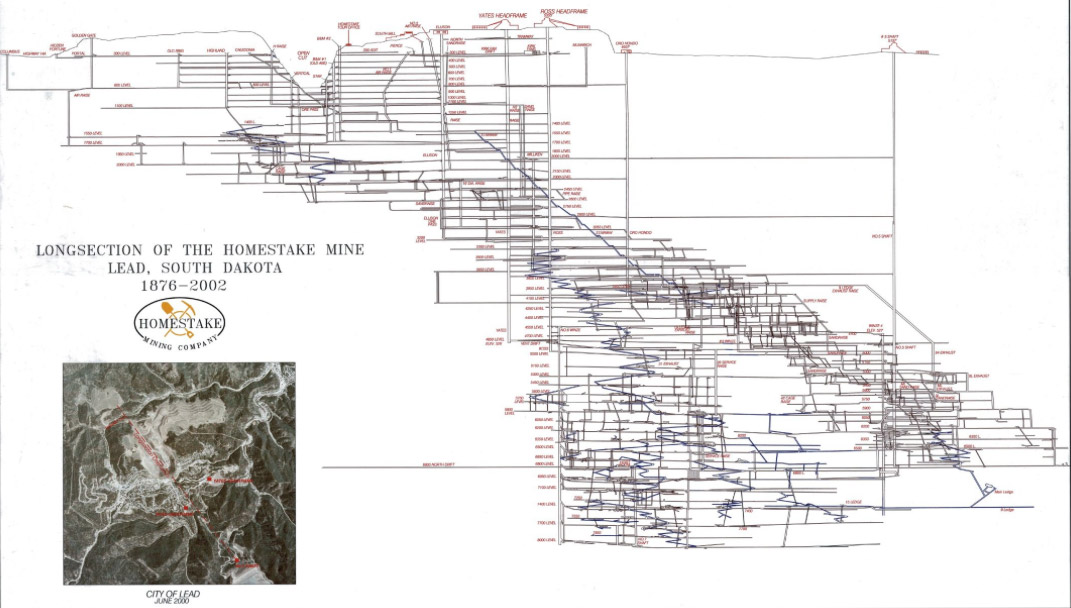
By the time of the Homestake Mine’s 100s anniversary in 1976, it had achieved a remarkable depth of 8,000 feet. By this milestone, the mine had processed more than 115 million tons of ore, resulting in the production of over 31 million ounces of gold and 7 million ounces of silver.
The Homestake Gold Mine closed in 2001 after 126 years of production.
The former Homestake Mine was repurposed into the Sanford Underground Research Facility, a major center for underground science, including physics and geology research.
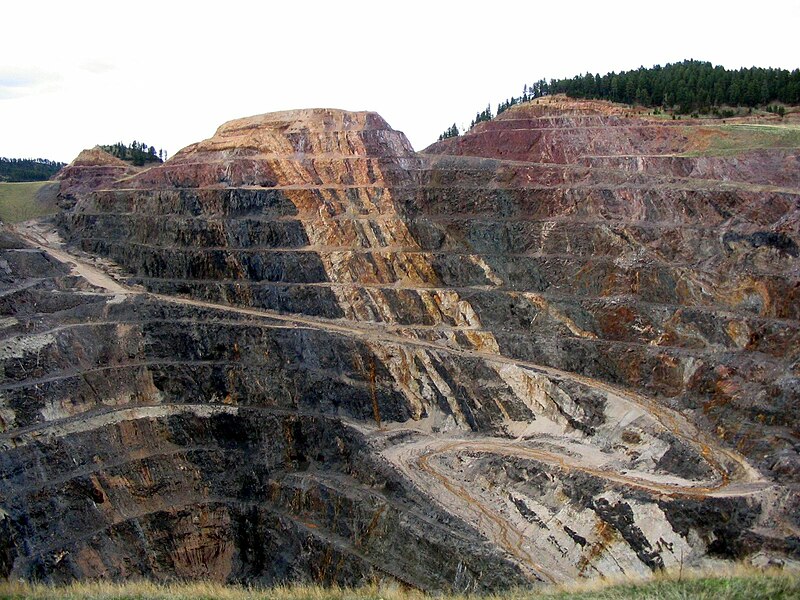
The Black Hills region, particularly the Homestake Mine, was a major source of gold, with about 90 percent of the recorded gold production in South Dakota coming from this area
By 1880, USD 6 million to USD 8 million gold had been mined, with half from placer gold.

Sources: Mining History Association, Mining History Association
How Much Gold has been Mined in South Dakota?
South Dakota produced 31,207,892 ounces of gold till 1965 (see chart).
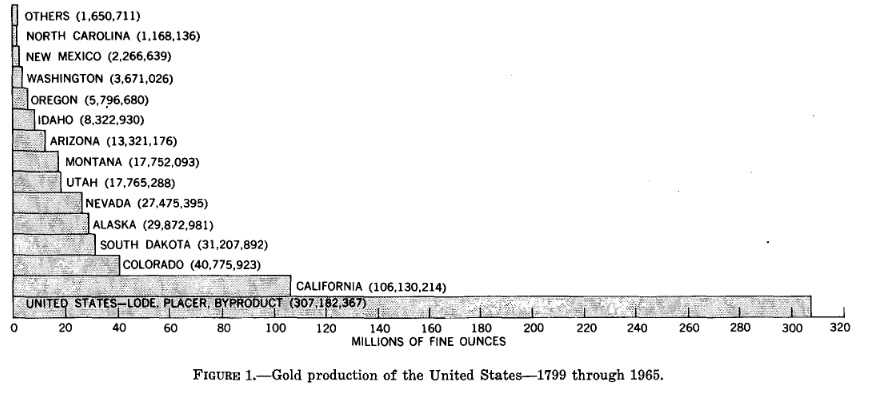
This increased to 34,694,552 ounces of gold by 1971. 90% of it came from the Homestake mine.
Approximately 90% of this output originated the Homestake mine, located in Lead, within the northern Black Hills. The majority of the remaining gold was extracted from the Deadwood Formation.
Notably, about 99% of South Dakota’s total gold production occurred within a 5-mile (8-kilometer) radius of Lead.
What is the Current State of Gold Mining in South Dakota?
The current state of gold mining in South Dakota is characterized by only one active gold mine in the state after the Homestake mine closed in 2001. Former mines have been transformed into tourist attractions.
For a chart of the annual gold output in South Dakota from 1993 till 2021, see chart below:
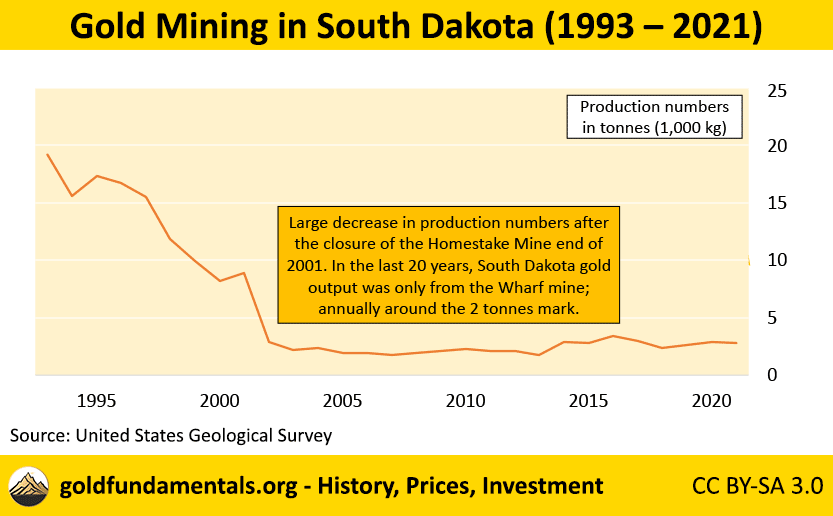
What is the major gold mine in South Dakota?
The US Geological Survey Minerals Yearbook lists in its most recent overview of 44 leading gold operations in the US only one gold producing operation in the state of South Dakota: Wharf mine (owned by Coeur Mining Inc.).
The US state that leads the ranking is Nevada with 27 operations, followed by Alaska with four operations.
List of the gold operation in South Dakota:
| US Rank | Operation | County and State | Majority Owner (2024) | Qty 2020 |
Qty 2021 |
|---|---|---|---|---|---|
| 19 | Wharf Mine | Lawrence, SD | Coeur Mining Inc. | 2.890 | 2.830 |
Explanation:
Rank: a comparison of the output of US mines. Therefore, Wharf mine, as the only South Dakota mine, is ranked number 19 of all US gold mines. Eight of the ten biggest mines are in Nevada and one in Alaska and one in Colorado.
Quantity: in kilogram; there are approx. 32 fine ounces in one kilogram
The Wharf mine consists of a series of open pits. It is located near the town of Lead Lawrence county in the Black Hills. It is in continuous operation since 1982.
Video about the Wharf mine:
This is the only mine that shares a hill with a ski resort. In 1877 the first claims were staked over the current-day Wharf mine. Since 2015 Coeur Mining Inc. became the sole owner of the mine. Its production was 2.830 kg in 2021. Mine Life till 2030.
Sources: company website, mdo, USGS
How Many Gold Reserves are in South Dakota?
Gold reserves based on the estimates of Wharf, the only gold mine in South Dakota, stand at: 293,000 ounce measured and indicated resources and 63,000 ounce of inferred resources (all cointained).
Source: company website
What Companies Mine Gold in South Dakota?
Coeur Mining Inc., a NYSE listed, precious metal mining company fully owns the only large gold mine in California, the Wharf mine. The company is Chicago-based, was founded in 1928 and employs nearly 2.000 people.
The company has four operations and one exploration project.
In detail:
- Palmarejo gold-silver operation in Mexico
- Rochester gold-silver operation in Nevada
- Kensington gold operation in Alaska
- Wharf gold operation in South Dakota
- Silvertip silver-zinc-lead exploration project in British Columbia
Source: company website
Where are New Gold Mines Explored or Developed in South Dakota?
There are several gold exploration projects in the Black Hills of South Dakota:
Dakota Gold’s Project:
- Dakota Gold plans to revitalize the Homestake district
- The company has been actively engaged in drilling activities at the Maitland Gold and Richmond Hill Gold Projects in the Black Hills of South Dakota since spring 2022.
- This project has yielded significant gold mineralization.
- The drilling at Richmond Hill has delineated an extensive gold system.
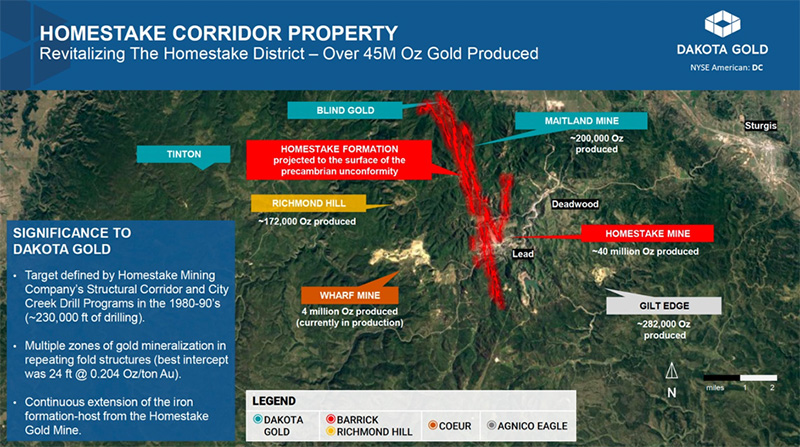
Solitario’s Golden Crest Project:
- Gold project also in the Homestake gold district
- Solitario plans to conduct advanced gold exploration, including a drilling program initiated in 2022, subject to the completion of necessary permitting
Sources: company websites
Is it Legal to Mine Gold in South Dakota?
In South Dakota, it is legal to mine gold under certain regulations.
- Public areas like the Black Hills National Forest and Badlands National Park are open for gold panning without the need for a permit.
- However, using mechanical equipment such as dredges or motorized pumps is illegal, and only hand tools are allowed for gold panning activities.
- Private companies also offer guided tours and access to their mining claims for a fee, which may have additional regulations.
- For larger scale operations, mine permits are required, with specific requirements for different scales of mining activities and the use of certain substances like cyanide.
- The South Dakota Department of Agriculture and Natural Resources oversees the issuance of mine permits and compliance with mining regulations
Sources: Forest Service
Where Can I Pan for Gold in South Dakota?
Check out the video about gold panning in South Dakota:
South Dakota, particularly the Black Hills area, offers several locations where you can legally pan for gold. Here are some popular spots:
- Black Hills National Forest: Gold panning is allowed in the Black Hills National Forest, but you need to follow the Forest Service regulations. This includes panning in designated areas and ensuring that you do not disturb the environment.
- Rapid Creek and Spearfish Creek: These creeks within the Black Hills are known for small-scale gold panning. Remember to respect private property rights and ensure you are on public land.
- Deadwood: This historic town, famous for its gold rush history, has areas nearby where recreational gold panning is permitted.
- Big Thunder Gold Mine: Located in Keystone, this mine offers gold panning as a tourist activity. It’s a great option for beginners or those interested in learning more about gold mining history.
- Wade’s Gold Mill: Located in Hill City, Wade’s Gold Mill offers gold panning and mining tours. It’s a family-friendly location that provides an educational perspective on the gold mining process.
- Nugget Gulch: Located near Deadwood, Nugget Gulch is another area where you can try your luck at gold panning.
Sources: travel South Dakota
Is There Gold in Other US States?
Check out gold production in neighboring states of South Dakota: North Dakota, Minnesota, Iowa, Nebraska, Wyoming and Montana.
According to the U.S. Geological Survey (USGC), there are 11 states that mine gold and contribute towards the gold mining statistic: Nevada is responsible for the majority of gold output, around 72%, followed by Alaska (13%). 9 other contribute in sum to the remaining 15% of gold production: Arizona, California, Colorado, Idaho, Michigan, New Mexico, South Carolina, South Dakota, and Utah.
